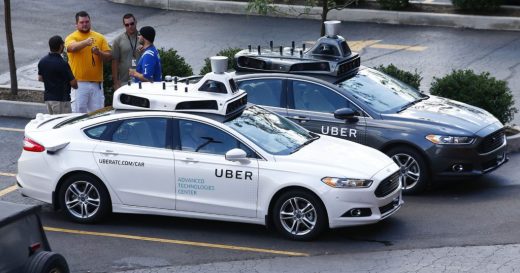Get ready for a thermonuclear autonomous ride-hailing war
Get ready for a thermonuclear autonomous ride-hailing war

On Thursday, Ford CEO Mark Fields announced the company’s first autonomous car will arrive in 2021. That big news—even if the launch date is timid from the company that invented the first affordable car—but the even bigger story is a ride-hailing app will be the easiest (and cheapest) way to ride in the unnamed autonomous car.
Ford did not name the ride-hailing app it plans to launch in major cities, but it is clear the company is positioning for its own stake in the ride-hailing industry. Its not hard to see why, estimates from economists and transport experts say car autonomy will reduce car sales and car ownership, which takes a slice out of the automotive industry’s pie.
See Also: Uber swallows self-driving truck startup Otto for $ 680 million
Uber, Lyft, and Didi are the three major firms that stand to gain from the reduction in car ownership, but they won’t be alone in the battle to win the ride-hailing market.
Automotive firms are gearing up for the battle of their lives. General Motors spent $ 600 million on a 40 person automation startup; Volkswagen, GM, Daimler, BMW, and Ford are all working on ride-hailing apps; Toyota, GM, Ford, Audi, BMW, and others have opened Silicon Valley offices and spent more on R&D than ever before.
Not to mention Apple and Google, the two most valuable companies in the world, are both working on self-driving and ride-hailing services.
A new world ride-hailing war?
Automotive firms are putting on their cooperative face, but come 2020 there will be thermonuclear war for ride-hailing market share. Every automotive firm will have its own ride-hailing app and software will be inserted into the car to make sure Uber, Lyft, or Didi can’t hijack it.
For Uber and Didi, that might force them to acquire an automotive manufacturer. For others that have less than $ 5 billion tucked away, it likely means lights out. Lyft could become an independent subsidiary of GM (or another larger company), a similar situation could play out in Europe with Gett and Volkswagen.
Partnerships may work for a time, but automotive firms have the power. Apart from Uber and Didi—who are building their own autonomous systems—automotive manufacturers will provide the hardware and software, putting them in a clearly advantageous position.
Volvo and Fiat are providing 100 cars to Uber and Google, respectively. It should be noted these two firms will have limited reach in the self-driving world, compared to major automotive manufacturers. In the future, we may see Uber, Google, or Didi dictate the design and production of the car, to meet standards, while the two firms have independent leadership.
Room for more?
The ride-hailing industry should look like the auto industry today, once the dust clears. Ford, GM, VW, and the other major suppliers will have the largest volume of cars on the road, while others attempt to win customers over with unique design, better software and services, or lower rates.
This only works if automotive manufacturers block ride-hailing services from adding software to their cars. If not, Uber takes control. Most affiliate ride-hailing with Uber, it will be nearly impossible for one of the upstarts (apart of Didi) to match the purchasing power and scalability of Uber.
Apple may make inroads, as it is able to provide the full package, but it may take the iPhone maker a few years to reach the scale of GM and Ford, who in this scenario are providing cars directly to Uber.
For the health of the auto industry, the former option; having manufacturers provide the ride-hailing services for their own cars, looks best. Some manufacturers will be unable to compete with Uber’s pricing and speed, but at least in this future customers have the choice of several operators, rather than the entire industry belonging to Uber.
The future of car ownership
It is unlikely that Ford, GM, and others will ban ownership out of the gate. Instead, it is likely that changes in cost, city planning, and laws will make ownership more exclusive and less enjoyable.
Prices will be too high for most families, while ride-hailing becomes much more affordable. City planners will remove parking garages and ban parking on the side of the road for extended periods of time. Driver’s licenses will become near impossible to obtain, unless you have clear sight, a clean record, and perfect understanding of all road signs.
Some may continue to purchase cars and be distrustful of autonomy, but most will conform once the economical advantages become obvious. Even fans of cars that add customizations will start to see their pastime fade, as the steering wheel, brakes, and other manual controls are removed in favor of tablets and desks.
Automotive manufacturers and tech firms may attempt to make the transition from ownership to hailing more attractive through customization. When you enter the autonomous car, your Spotify playlist is synced to the car stereo or your YouTube video moves to the large tablet. In the morning, the car plays soothing tunes and dims the lights. If you’re a big NFL fan, perhaps Google will let you watch the livestream for free if you take a ride.
See Also: Self-driving? You’re gonna need a bigger data plan
We may see different business models rise, including a rent model where you can keep a car in close permitter for 24 hours. That may be useful for weekend trips to the countryside, where the ride-hailing services are unavailable. As the systems become more fine-tuned, it may deploy a car to your doorstep in the morning before you even order it.
All of this is highly speculative, but one thing is for certain, a new warzone is opening in the transport industry and everyone is fortifying their positions.
The post Get ready for a thermonuclear autonomous ride-hailing war appeared first on ReadWrite.
(21)













